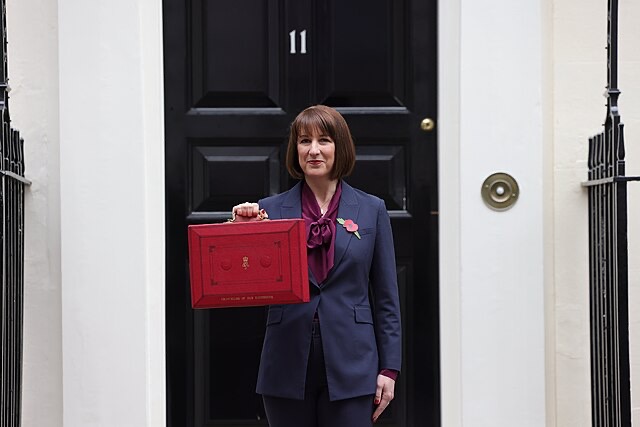30-year gilt yields hit 5.57 per cent as inflation fears mount and Government’s fiscal position comes under scrutiny
Government borrowing costs have soared to their highest levels in 27 years, piling pressure on Chancellor Rachel Reeves as investors grow increasingly anxious about the UK’s ability to manage its mounting debt burden.
The 30-year gilt yield climbed to 5.57 per cent on Friday (August 15), before easing slightly to 5.54 per cent when markets opened on Monday morning (August 18). This marks the highest level since 1998, surpassing even the peaks seen in April when gilt yields spiked following President Donald Trump’s “Liberation Day” tariffs announcement.
The surge in borrowing costs reflects growing market unease about major economies‘ ability to service their debts, with the UK facing particular scrutiny due to what analysts describe as its “weak fiscal position.
Rising Inflation Threatens Interest Rate Cuts
The Bank of England has warned that inflation is set to rise to four per cent next month – double its target rate – creating fresh headaches for policymakers who have been attempting to ease monetary conditions after years of high interest rates.
The central bank has reduced its base rate from a peak of 5.25 per cent to the current level of four per cent, following its latest quarter-point cut on 7 August. However, the prospect of inflation rising again threatens to keep rates “higher for longer,” analysts warn.
“The spike in European bond yields coincided with the release of the UK labour market data, which showed stubbornly high wage data and a slowdown in job losses in recent weeks and months,” Kathleen Brooks, research director at trading platform XTB, told City AM.
UK Underperforms Global Markets
Perhaps most concerning for the Chancellor is that UK gilt yields are rising faster than equivalent yields in both the United States and Europe, suggesting investors are particularly worried about Britain’s economic prospects.
The 10-year gilt yield rose to as much as 4.7 per cent from 4.51 per cent, though this remains below the levels seen in April and June. The divergence between UK and international borrowing costs highlights specific concerns about the British economy’s trajectory.
Brooks warned: “Interest rate cut expectations for the UK are being scaled back, there is now less than one rate cut getting priced in by the end of the year, and only a 40 per cent chance of a cut priced in for November.
Spending Decisions Under Fire
The Government’s spending choices have contributed significantly to the gilt yield movements. Chancellor Reeves was forced to scale back planned spending cuts on benefits expenditure following a backlash from backbench Labour MPs over the Universal Credit and Personal Independence Payment Bill.
This U-turn effectively wiped out £5 billion of anticipated savings, raising the prospect of further tax rises in the autumn despite Reeves’s pledge that she wouldn’t need to raise taxes again during Labour’s term in office.
The pressure on public finances is stark. Speaking to the Treasury Select Committee earlier this year, Reeves highlighted the burden of debt servicing costs: “One in £10 of Government spending is spent servicing our debt. I am a Labour politician. I don’t think there’s anything progressive about spending £100billion a year, often to US hedge funds when I would rather spend that money on our health service or on defence.
‘Non-Negotiable’ Fiscal Rules Under Strain
The Chancellor has declared her strict fiscal rules “non-negotiable,” promising not to raise taxes on working people. However, with borrowing costs soaring and spending pressures mounting, these commitments are looking increasingly difficult to maintain.
The Office for Budget Responsibility has warned that annual interest payments on the national debt could exceed £100 billion for the rest of this Parliament – a serious and growing strain on the public purse that limits the Government’s room for manoeuvre.
“For now, UK bonds are taking the brunt of the selling, and Gilt yields are rising faster than yields in Europe and the US. Due to the UK’s weak fiscal position, this is to be expected,” Brooks explained.
Market Volatility Reflects Global Concerns
The bond market turbulence reflects broader global concerns about inflation and fiscal sustainability. The sell-off has been partly driven by fears over potential Trump tariff policies and their inflationary impact on international economies.
During periods of market stress last month, yields on 30-year gilts briefly hit 5.63 per cent during a global bond sell-off. The pound has also come under pressure, slipping against both the dollar and the euro as investors reassess UK assets.
Critical Dates Ahead
All eyes will now turn to two critical dates in the coming weeks. The Bank of England’s Monetary Policy Committee is scheduled to announce its next interest rate decision on September 18, 2025. Market participants will be watching closely for any signals about the future path of monetary policy.
Meanwhile, the Chancellor is expected to deliver her Autumn Budget statement sometime in late October or early November, though no date has been confirmed by the Treasury. This budget will be crucial in determining whether Reeves can maintain her fiscal rules whilst addressing the mounting pressures on public spending.
The surge in borrowing costs comes at a particularly challenging time for the Government, which must balance the need for fiscal discipline with demands for increased public spending on services. With inflation threatening to rise again and borrowing costs at multi-decade highs, the Chancellor’s room for manoeuvre appears increasingly limited.
As one Treasury insider put it: “The honeymoon period is well and truly over. The markets are now putting Rachel Reeves’s economic strategy to the test, and the results so far are concerning.
Follow for more updates on Britannia Daily
Image Credit (Shortened):
Chancellor Rachel Reeves delivers the Autumn Budget 2024 (30 Oct 2024) – by Kirsty O’Connor / Treasury, licensed under OGL v3.0, via Wikimedia Commons.



